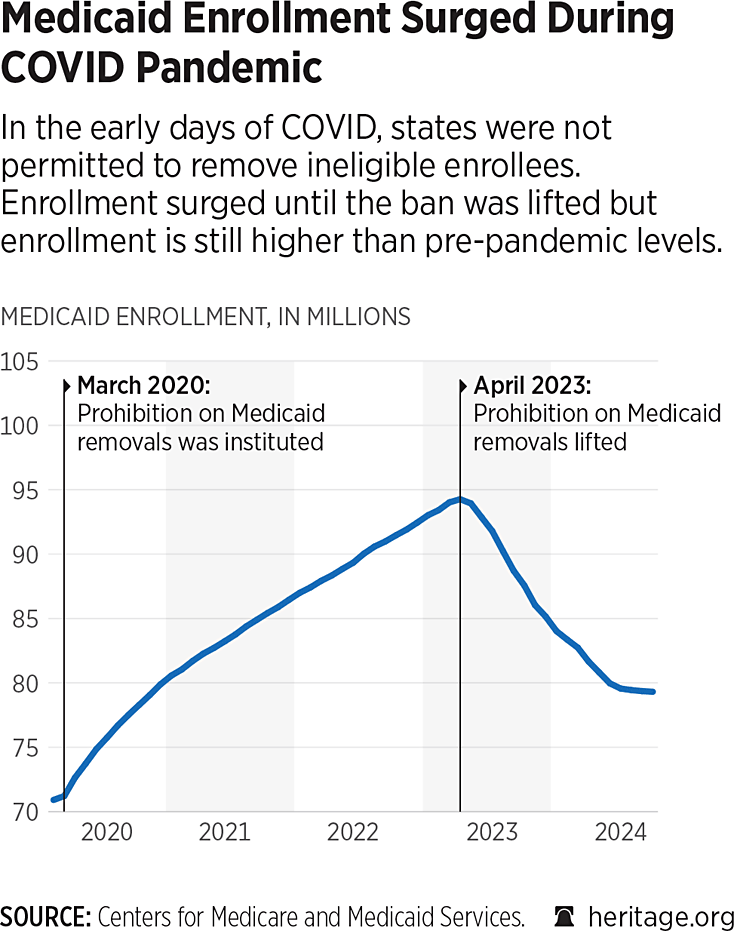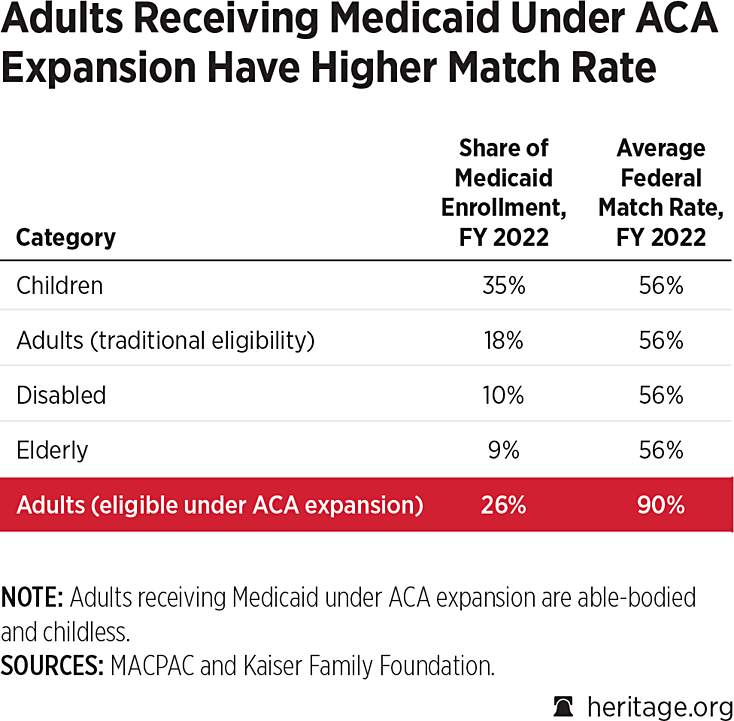The Issue
Liberal attempts to stoke fears that changes to Medicaid are dangerous and harmful are more about protecting the status quo than protecting the program. Those who genuinely want to protect Medicaid should not be fooled by these claims. Reforms to Medicaid are much needed and overdue.
Background
- Medicaid is a joint federal–state health program that serves a broad and diverse group of low-income Americans, providing health care to a quarter of the U.S. population. In November 2024, an estimated 79 million individuals were covered by Medicaid.
- The Medicaid costs are shared between the federal government and the states. Total federal and state spending on Medicaid was projected to reach $833.5 billion in 2024 ($532.6 billion in federal spending and $300.9 billion in state spending).
Commonsense Medicaid Reforms
A number of practical, commonsense reforms can weed out fraud, waste, and abuse in Medicaid, bringing greater fairness and accountability to the program. Congress should:
- Enforce and strengthen eligibility rules. During the COVID-19 pandemic, Medicaid had a significant surge in enrollment. Due to restrictions on the states preventing them from verifying eligibility during the pandemic, total enrollment jumped from 70 million in February 2020 to a high of 94 million in April 2023. Today, despite states reviving eligibility verification, the number of enrollees remains higher than it was before the pandemic. Congress should roll back Biden-era policies that are aimed at maximizing higher enrollment rather than enforcing eligibility rules.

- Stop favoring abled-bodied, childless adults over other groups. The Affordable Care Act (ACA) created a new Medicaid eligibility category: able-bodied, childless adults. To entice states to adopt this expansion, the federal government raised its share of the contribution to 90 percent. This distorted financing provides incentives to prioritize enrollment of the new group over traditional Medicaid populations. As a result, the expansion group now makes up a greater share of total Medicaid enrollment than other previously eligible groups. Congress should replace the higher ACA match rate for able-bodied, childless adults with the standard match rate.

- End state-financing gimmicks and close loopholes. States have developed a number of financing tricks to draw down federal Medicaid dollars. For example, states tax Medicaid providers to meet their state share only to refund those providers with higher Medicaid reimbursements. The use of provider taxes has jumped as a source of revenue from 7 percent in state fiscal year (SFY) 2008 to 17 percent in SFY 2018. Congress should eliminate or further tighten states’ use of provider taxes and other financing schemes used to meet a state’s match for Medicaid costs.
- Allow work requirements as a condition of receiving benefits. Like in other welfare programs, certain able-bodied Medicaid enrollees should be required to work or look for work as a condition of receiving benefits. The first Trump Administration approved a number of state proposals to put in place a work requirement. The Biden Administration reversed course and rescinded those agreements. The second Trump Administration should revive those efforts, and Congress should follow with additional statutory changes and guidance.
- Restructure, reorganize, and reauthorize the program. After 60 years, Medicaid is overdue for a full evaluation of its purpose, scope, and results. By 2032, 85 million people are projected to be enrolled in Medicaid and total spending is expected to reach $1.3 trillion. Congress should initiate a process to consider larger policy changes, including reassessing the eligibility, benefits, and financing framework, to bring greater predictability, certainty, and sustainability to the program.
Congress Should Seize the Opportunity Now
Renewed interest on the part of Congress in addressing the stark challenges facing Medicaid is a welcome development. Congress should now seize the opportunity to advance commonsense Medicaid reforms that will better serve enrollees and taxpayers alike.




